2019 Hyundai Santa Fe trailer
[x] Cancel search: trailerPage 471 of 682
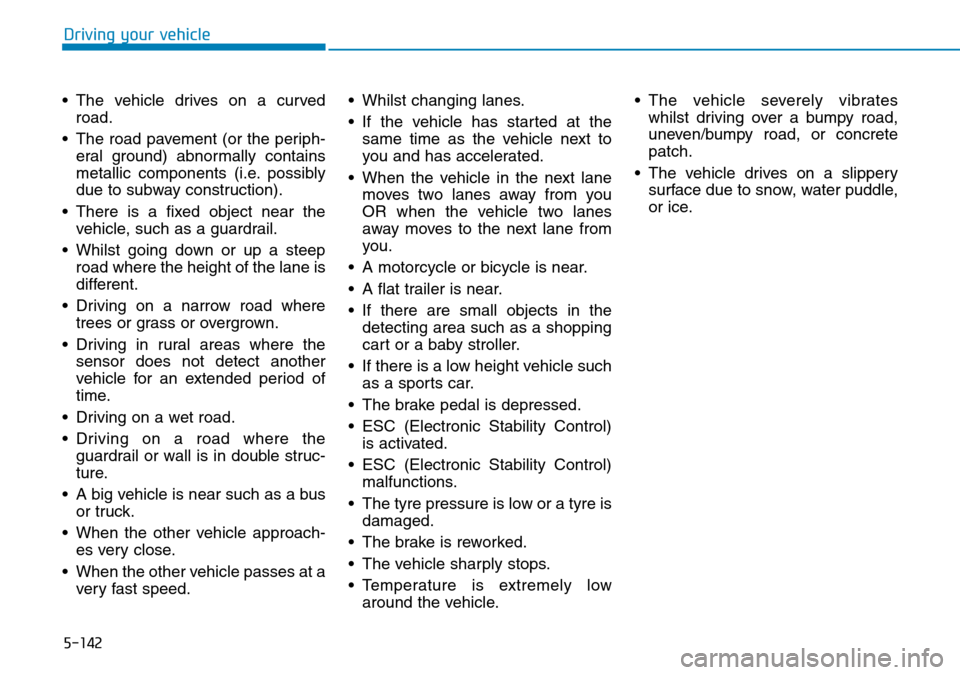
5-142
Driving your vehicle
• The vehicle drives on a curved
road.
• The road pavement (or the periph-
eral ground) abnormally contains
metallic components (i.e. possibly
due to subway construction).
• There is a fixed object near the
vehicle, such as a guardrail.
• Whilst going down or up a steep
road where the height of the lane is
different.
• Driving on a narrow road where
trees or grass or overgrown.
• Driving in rural areas where the
sensor does not detect another
vehicle for an extended period of
time.
• Driving on a wet road.
• Driving on a road where the
guardrail or wall is in double struc-
ture.
• A big vehicle is near such as a bus
or truck.
• When the other vehicle approach-
es very close.
• When the other vehicle passes at a
very fast speed.• Whilst changing lanes.
• If the vehicle has started at the
same time as the vehicle next to
you and has accelerated.
• When the vehicle in the next lane
moves two lanes away from you
OR when the vehicle two lanes
away moves to the next lane from
you.
• A motorcycle or bicycle is near.
• A flat trailer is near.
• If there are small objects in the
detecting area such as a shopping
cart or a baby stroller.
• If there is a low height vehicle such
as a sports car.
• The brake pedal is depressed.
• ESC (Electronic Stability Control)
is activated.
• ESC (Electronic Stability Control)
malfunctions.
• The tyre pressure is low or a tyre is
damaged.
• The brake is reworked.
• The vehicle sharply stops.
• Temperature is extremely low
around the vehicle.• The vehicle severely vibrates
whilst driving over a bumpy road,
uneven/bumpy road, or concrete
patch.
• The vehicle drives on a slippery
surface due to snow, water puddle,
or ice.
Page 475 of 682
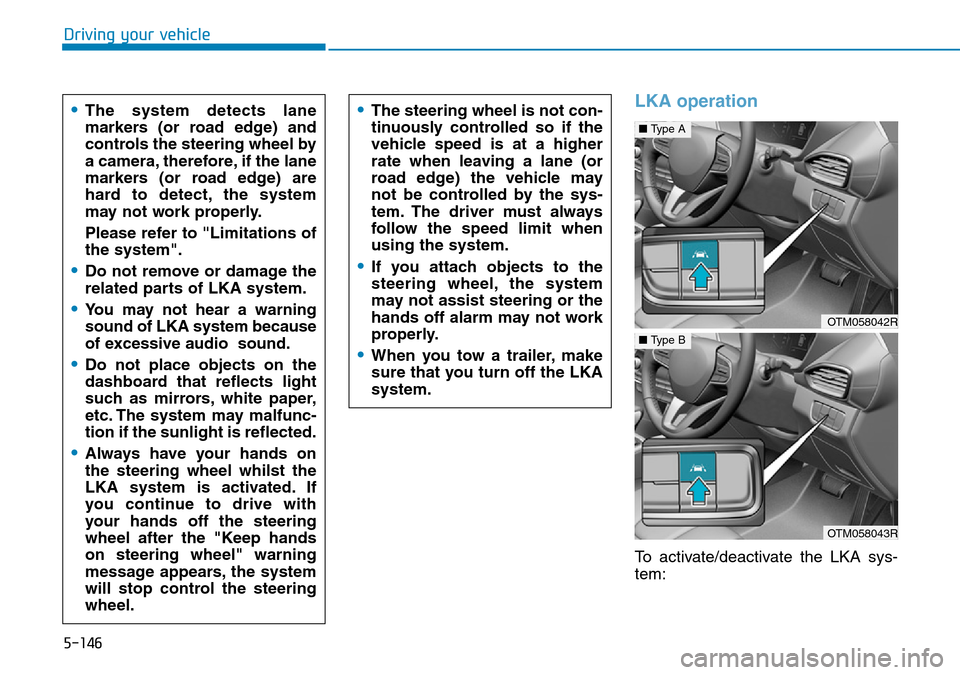
5-146
Driving your vehicle
LKA operation
To activate/deactivate the LKA sys-
tem:
•The system detects lane
markers (or road edge) and
controls the steering wheel by
a camera, therefore, if the lane
markers (or road edge) are
hard to detect, the system
may not work properly.
Please refer to "Limitations of
the system".
•Do not remove or damage the
related parts of LKA system.
•You may not hear a warning
sound of LKA system because
of excessive audio sound.
•Do not place objects on the
dashboard that reflects light
such as mirrors, white paper,
etc. The system may malfunc-
tion if the sunlight is reflected.
•Always have your hands on
the steering wheel whilst the
LKA system is activated. If
you continue to drive with
your hands off the steering
wheel after the "Keep hands
on steering wheel" warning
message appears, the system
will stop control the steering
wheel.
•The steering wheel is not con-
tinuously controlled so if the
vehicle speed is at a higher
rate when leaving a lane (or
road edge) the vehicle may
not be controlled by the sys-
tem. The driver must always
follow the speed limit when
using the system.
•If you attach objects to the
steering wheel, the system
may not assist steering or the
hands off alarm may not work
properly.
•When you tow a trailer, make
sure that you turn off the LKA
system.
OTM058042R
■Type A
OTM058043R
■Type B
Page 493 of 682
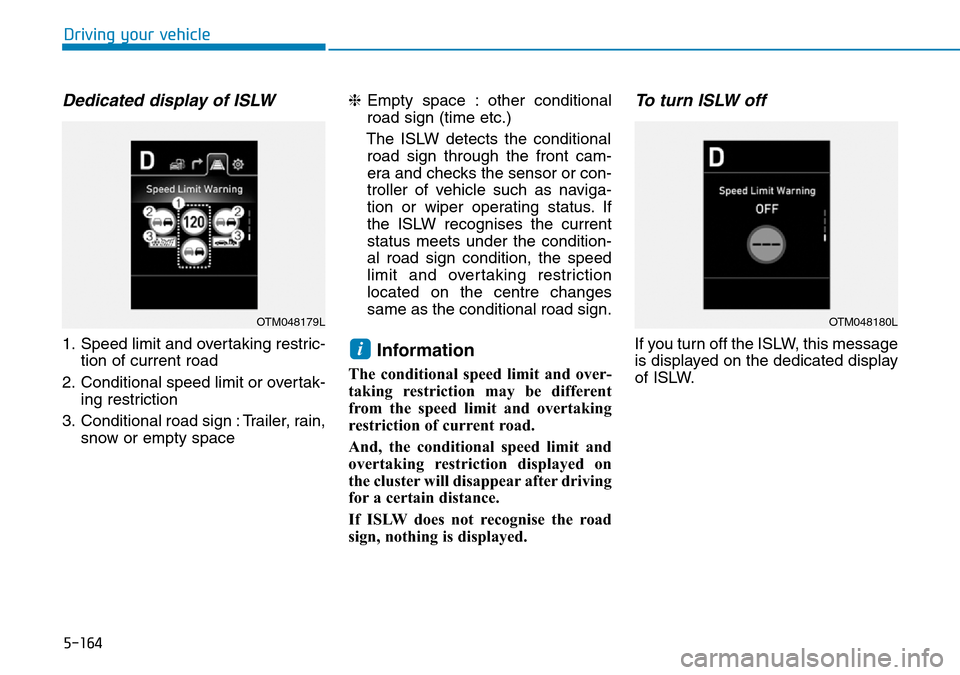
5-164
Driving your vehicle
Dedicated display of ISLW
1. Speed limit and overtaking restric-
tion of current road
2. Conditional speed limit or overtak-
ing restriction
3. Conditional road sign : Trailer, rain,
snow or empty space❈Empty space : other conditional
road sign (time etc.)
The ISLW detects the conditional
road sign through the front cam-
era and checks the sensor or con-
troller of vehicle such as naviga-
tion or wiper operating status. If
the ISLW recognises the current
status meets under the condition-
al road sign condition, the speed
limit and overtaking restriction
located on the centre changes
same as the conditional road sign.Information
The conditional speed limit and over-
taking restriction may be different
from the speed limit and overtaking
restriction of current road.
And, the conditional speed limit and
overtaking restriction displayed on
the cluster will disappear after driving
for a certain distance.
If ISLW does not recognise the road
sign, nothing is displayed.
To turn ISLW off
If you turn off the ISLW, this message
is displayed on the dedicated display
of ISLW.i
OTM048179LOTM048180L
Page 494 of 682
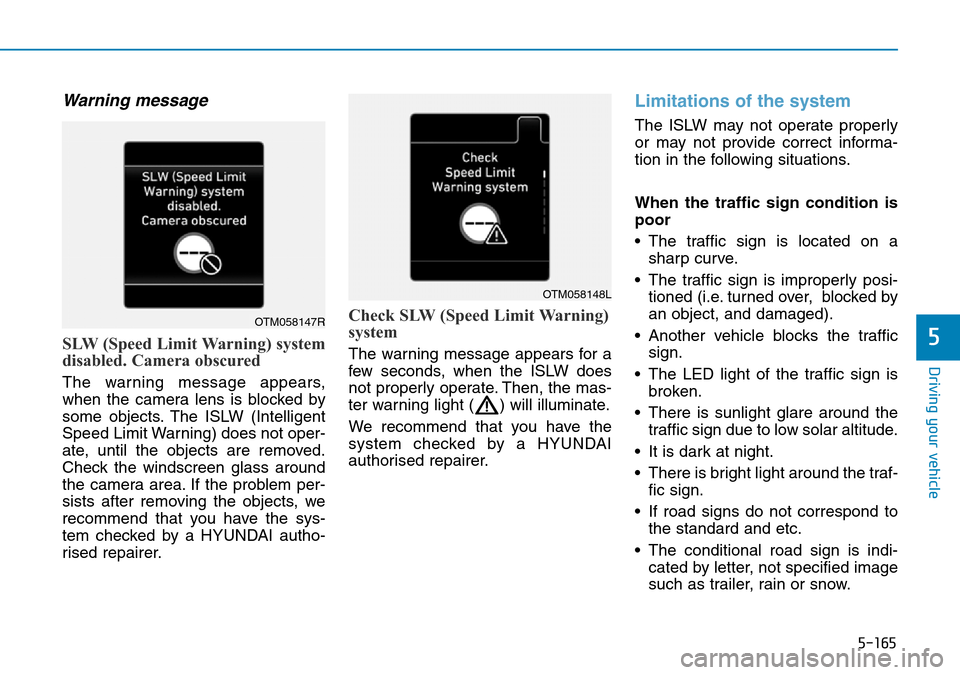
5-165
Driving your vehicle
5
Warning message
SLW (Speed Limit Warning) system
disabled. Camera obscured
The warning message appears,
when the camera lens is blocked by
some objects. The ISLW (Intelligent
Speed Limit Warning) does not oper-
ate, until the objects are removed.
Check the windscreen glass around
the camera area. If the problem per-
sists after removing the objects, we
recommend that you have the sys-
tem checked by a HYUNDAI autho-
rised repairer.
Check SLW (Speed Limit Warning)
system
The warning message appears for a
few seconds, when the ISLW does
not properly operate. Then, the mas-
ter warning light ( ) will illuminate.
We recommend that you have the
system checked by a HYUNDAI
authorised repairer.
Limitations of the system
The ISLW may not operate properly
or may not provide correct informa-
tion in the following situations.
When the traffic sign condition is
poor
• The traffic sign is located on a
sharp curve.
• The traffic sign is improperly posi-
tioned (i.e. turned over, blocked by
an object, and damaged).
• Another vehicle blocks the traffic
sign.
• The LED light of the traffic sign is
broken.
• There is sunlight glare around the
traffic sign due to low solar altitude.
• It is dark at night.
• There is bright light around the traf-
fic sign.
• If road signs do not correspond to
the standard and etc.
• The conditional road sign is indi-
cated by letter, not specified image
such as trailer, rain or snow.
OTM058148L
OTM058147R
Page 516 of 682
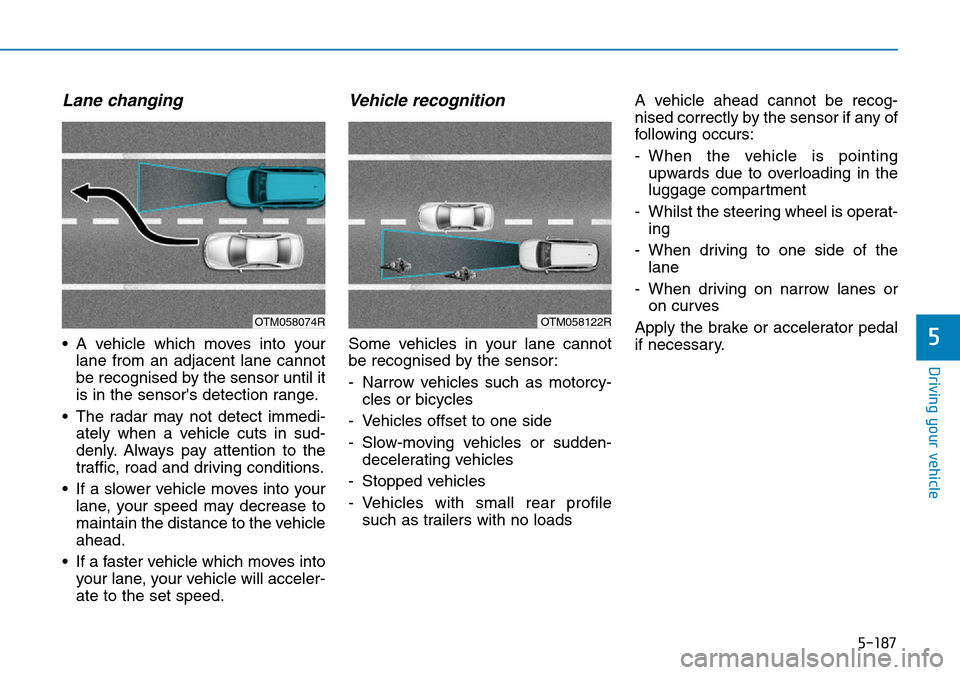
5-187
Driving your vehicle
5
Lane changing
• A vehicle which moves into your
lane from an adjacent lane cannot
be recognised by the sensor until it
is in the sensor's detection range.
• The radar may not detect immedi-
ately when a vehicle cuts in sud-
denly. Always pay attention to the
traffic, road and driving conditions.
• If a slower vehicle moves into your
lane, your speed may decrease to
maintain the distance to the vehicle
ahead.
• If a faster vehicle which moves into
your lane, your vehicle will acceler-
ate to the set speed.
Vehicle recognition
Some vehicles in your lane cannot
be recognised by the sensor:
- Narrow vehicles such as motorcy-
cles or bicycles
- Vehicles offset to one side
- Slow-moving vehicles or sudden-
decelerating vehicles
- Stopped vehicles
- Vehicles with small rear profile
such as trailers with no loadsA vehicle ahead cannot be recog-
nised correctly by the sensor if any of
following occurs:
- When the vehicle is pointing
upwards due to overloading in the
luggage compartment
- Whilst the steering wheel is operat-
ing
- When driving to one side of the
lane
- When driving on narrow lanes or
on curves
Apply the brake or accelerator pedal
if necessary.
OTM058074ROTM058122R
Page 529 of 682
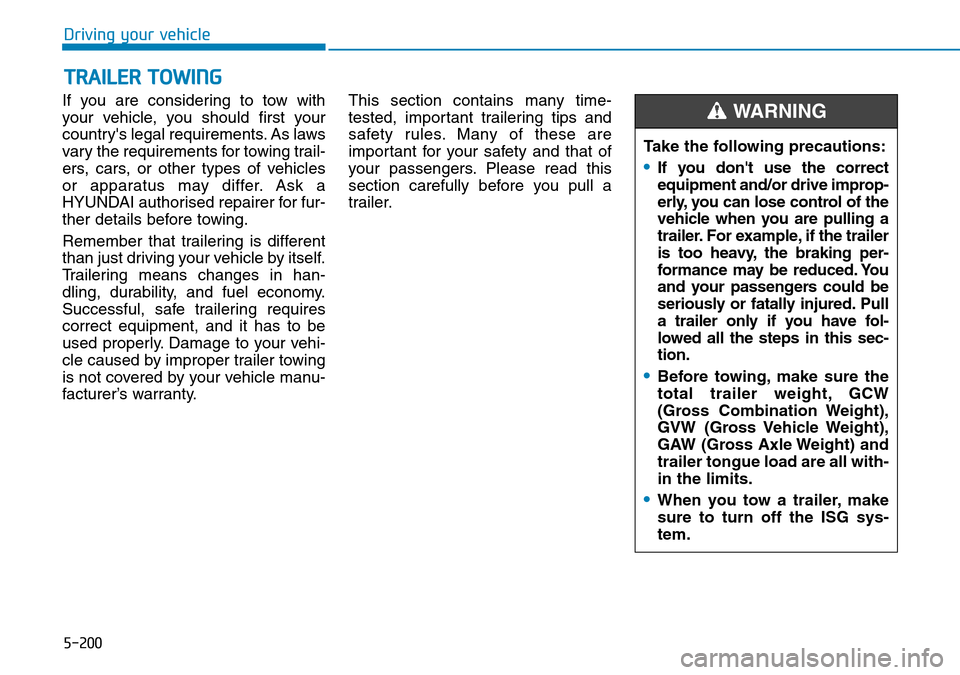
5-200
Driving your vehicle
If you are considering to tow with
your vehicle, you should first your
country's legal requirements. As laws
vary the requirements for towing trail-
ers, cars, or other types of vehicles
or apparatus may differ. Ask a
HYUNDAI authorised repairer for fur-
ther details before towing.
Remember that trailering is different
than just driving your vehicle by itself.
Trailering means changes in han-
dling, durability, and fuel economy.
Successful, safe trailering requires
correct equipment, and it has to be
used properly. Damage to your vehi-
cle caused by improper trailer towing
is not covered by your vehicle manu-
facturer’s warranty.This section contains many time-
tested, important trailering tips and
safety rules. Many of these are
important for your safety and that of
your passengers. Please read this
section carefully before you pull a
trailer.
TRAILER TOWING
Take the following precautions:
•If you don't use the correct
equipment and/or drive improp-
erly, you can lose control of the
vehicle when you are pulling a
trailer. For example, if the trailer
is too heavy, the braking per-
formance may be reduced. You
and your passengers could be
seriously or fatally injured. Pull
a trailer only if you have fol-
lowed all the steps in this sec-
tion.
•Before towing, make sure the
total trailer weight, GCW
(Gross Combination Weight),
GVW (Gross Vehicle Weight),
GAW (Gross Axle Weight) and
trailer tongue load are all with-
in the limits.
•When you tow a trailer, make
sure to turn off the ISG sys-
tem.
WARNING
Page 530 of 682
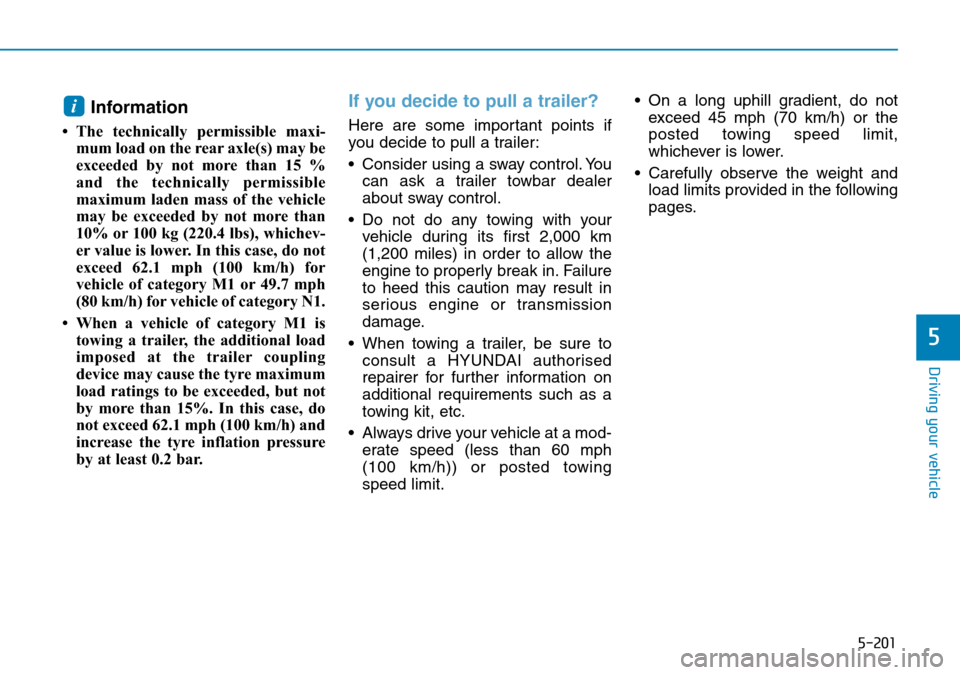
5-201
Driving your vehicle
5
Information
• The technically permissible maxi-
mum load on the rear axle(s) may be
exceeded by not more than 15 %
and the technically permissible
maximum laden mass of the vehicle
may be exceeded by not more than
10% or 100 kg (220.4 lbs), whichev-
er value is lower. In this case, do not
exceed 62.1 mph (100 km/h) for
vehicle of category M1 or 49.7 mph
(80 km/h) for vehicle of category N1.
• When a vehicle of category M1 is
towing a trailer, the additional load
imposed at the trailer coupling
device may cause the tyre maximum
load ratings to be exceeded, but not
by more than 15%. In this case, do
not exceed 62.1 mph (100 km/h) and
increase the tyre inflation pressure
by at least 0.2 bar.
If you decide to pull a trailer?
Here are some important points if
you decide to pull a trailer:
• Consider using a sway control. You
can ask a trailer towbar dealer
about sway control.
• Do not do any towing with your
vehicle during its first 2,000 km
(1,200 miles) in order to allow the
engine to properly break in. Failure
to heed this caution may result in
serious engine or transmission
damage.
• When towing a trailer, be sure to
consult a HYUNDAI authorised
repairer for further information on
additional requirements such as a
towing kit, etc.
• Always drive your vehicle at a mod-
erate speed (less than 60 mph
(100 km/h)) or posted towing
speed limit.• On a long uphill gradient, do not
exceed 45 mph (70 km/h) or the
posted towing speed limit,
whichever is lower.
• Carefully observe the weight and
load limits provided in the following
pages.
i
Page 531 of 682

5-202
Driving your vehicle
Trailer weight
What is the maximum safe weight of a
trailer? It should never weigh more
than the maximum trailer weight with
trailer brakes. But even that can be
too heavy. It depends on how you plan
to use your trailer. For example,
speed, altitude, road grades, outside
temperature and how often your vehi-
cle is used to pull a trailer are all
important. The ideal trailer weight can
also depend on any special equip-
ment that you have on your vehicle.
Tongue load
The tongue load is an important
weight to measure because it affects
the total Gross Vehicle Weight
(GVW) of your vehicle. The trailer
tongue should weigh a maximum of
10% of the total loaded trailer weight,
within the limits of the maximum trail-
er tongue load permissible.
After you've loaded your trailer,
weigh the trailer and then the tongue,
separately, to see if the weights are
proper. If they aren’t, you may be
able to correct them simply by mov-
ing some items around in the trailer.
Information
With increasing altitude the engine
performance decreases. From 1,000 m
above sea level and for every 1,000 m
thereafter 10% of vehicle/trailer
weight (trailer weighter + gross vehi-
cle weight) must be deducted.
i
Take the following precautions:
•Never load a trailer with more
weight in the rear than in the
front. The front should be
loaded with approximately
60% of the total trailer load;
the rear should be loaded with
approximately 40% of the total
trailer load.
•Never exceed the maximum
weight limits of the trailer or
trailer towing equipment.
Improper loading can result in
damage to your vehicle and/or
personal injury. Check weights
and loading at a commercial
scale or highway patrol office
equipped with scales.
WARNING
OLMB053048
Gross Axle WeightGross Vehicle Weight
OLMB053047
Tongue LoadTotal Trailer Weight